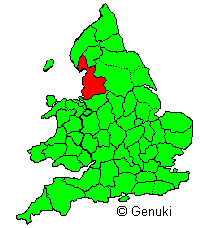 |
A county of England, lying on the Irish Sea, and bounded
by Cumberland, Westmoreland, Yorkshire, and Cheshire. It is 75 miles
in length, and 30 in breadth. It is divided into 6 hundreds, which
contain 27 market towns, 62 parishes, and 894 villages. This county
comprises a variety of soil and face of country; there being mountains
of more than 2000 feet high, in the north and eastern parts, with
wide moorlands or heaths amongst them; extensive bogs or mosses, which
yield only turf for fuel, and are very dangerous; and some most fertile
land for agricultural purposes. it yields iron, coal, slate, and other
building-stones; salt, &c. &c. Grazing is more attended to
than agriculture. The fisheries, both in the rivers and the sea, are
valuable. As a commercial and manufacturing county, Lancashire is
distinguished beyond most others in the kingdom. Its principal manufactures
are linen, silk, and cotton goods; fustians, counterpanes, shalloons,
baize, serges, tapes, small wares, hats, sail-cloth, sacking, pins,
iron goods, cast plate-glass, &c. Of the commerce of this county,
it may suffice to observe, that Liverpool is now the second port in
the United Kingdom. The principal rivers are the Mersey, Irwell, Ribble,
Lune, Leven, Wyre, Hodder, Roche, Duddon, Winster, Kent, and Calder,
and it has two considerable lakes, Windermere and Coniston Water.
Lancaster is the county town. Population, 1,667,054. It returns 26
members to parliament.
(From Barclay's Complete and Universal Dictionary of 1842.) |

